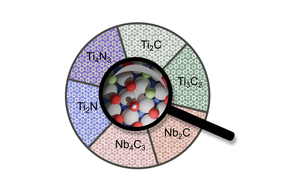A computational deep glance at 2-dimensional MXene materials reveals new insight about their surface properties


In their latest publication, researchers from the CEST group have studied the surface composition of several MXene-type materials computationally. MXenes find application in batteries, supercapacitors, electromagnetic shielding and surface sensors. The researchers explored different surface chemistry relevant for these applications and investigated the effects of different transition metals or a different number of atomic layers.
MXenes are two-dimensional (2D) transition metal carbides and nitrides that belong to a large class of 2D materials with extraordinary electronic, optical, mechanical, thermal, and catalytic properties. These materials have the general composition M_(n+1)X_n, where M is a transition metal and X a carbon or nitrogen atom, with n corresponding to atomic thickness. A key feature of MXenes is that their surface properties can be altered by controlling the composition of functional groups such as -O, -F, and -OH. Although a variety of MXene material properties are ascribed to their surface composition and hence functionalization, the actual structure, composition and functionality of these surfaces remain often unknown in real life.
In their current study, Rina Ibragimova and co-workers applied a multi-scale computational scheme that resulted in a realistic distribution of organic molecules on the surface of several MXenes. In addition, this model was able to demonstrate trends in the distribution and composition of surface functional groups. The researchers found that the distribution of these functional groups appears to be largely independent from the type of metal, carbon, or nitrogen used in the material, as well as from the number of atomic layers. Instead, the group shows for the first time that the distribution of these adsorbants is governed by the electrostatic nature of interactions between the molecules, and less by chemical interactions within the interior of the MXene layers. Ibragimova also successfully demonstrated the formation of mixed functional groups on the surface and explored a range of equilibrium compositions suitable for a range of experimental conditions (pH, potential, and temperature).
In doing so, the researchers achieved a solid understanding of MXene surface functionalization, including how this surface can be modified under controlled experimental conditions and how this in turn affects electronic and other properties. These results now enable experimentalists to better estimate the composition of functional groups under certain synthesis conditions and adjust these accordingly to their needs.
Ibragimova now wants to explore other aspects of the surface design of MXenes. That will include studies of the native defects formation in these materials and their relation with the surface functionalization.
The article is published in The Journal of Physical Chemistry Letters.
- Published:
- Updated:
Read more news

Min-Kyu Paek has been appointed Assistant Professor at the Department of Chemical and Metallurgical Engineering
Min-Kyu Paek has been appointed Assistant Professor at the Department of Chemical and Metallurgical Engineering
Aalto ARTS alum Vidha Samya’s artwork featured at the Venice Biennale 2024
The Pavilion of Finland presents ‘The pleasures we choose’ at the 60th International Art Exhibition – La Biennale di Venezia until 24 November 2024.
IoT Forge donates EUR 1 million to the School of Engineering
The donation will be used for research and education on the Industrial Internet and digital twins.